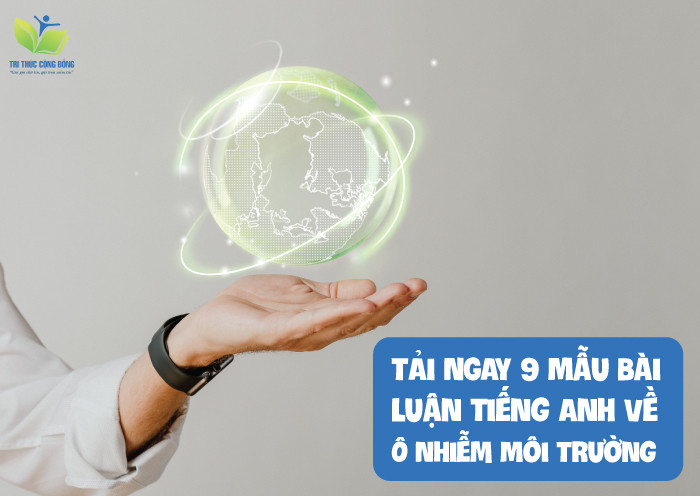Ngày nay tiếng anh ngày càng phổ biến, việc học song ngữ đã trở nên quen thuộc với các bạn sinh viên. Tuy nhiên trong khi viết bài luận tiếng anh nếu bạn vẫn cảm thấy khó khăn khi viết các chủ đề khác nhau. Bài viết dưới đây sẽ gửi tới bài 10 bài luận mẫu với các chủ đề tiêu biểu, thường gặp nhất. Hãy cùng tìm hiểu nhé.
1. Bài luận tiếng anh chủ đề công nghệ

Bài luận tiếng anh chủ đề công nghệ
Đề bài Ielts Writing Task 2: “Some people believe that technology has improved our lives in many ways, while others think it has created more problems than it has solved. Discuss both views and give your opinion.”
1.1. Dàn ý về tầm quan trọng của Technology
Introduction
- Mở bài: Công nghệ đã trở thành một phần không thể tách rời trong cuộc sống con người.
- Paraphrase: Nhiều người cho rằng công nghệ nâng cao hiệu quả và chất lượng cuộc sống, trong khi người khác tin rằng nó gây ra vấn đề xã hội và sự phụ thuộc.
- Thesis: Bài viết sẽ thảo luận cả hai quan điểm trước khi khẳng định lợi ích của công nghệ lớn hơn hạn chế.
- Collocations/Idioms gợi ý: inseparable part of life (phần không thể tách rời của cuộc sống), weigh the pros and cons (cân nhắc ưu và nhược điểm), outweigh the drawbacks (vượt trội hơn hạn chế)
Body 1 – Lợi ích của công nghệ
Topic sentence: Công nghệ mang lại nhiều lợi ích vượt trội trong các lĩnh vực then chốt.
Ý 1: Nâng cao giao tiếp, giáo dục, chăm sóc sức khỏe.
- Ví dụ: Online learning platforms, telemedicine.
- Collocations/Idioms: instant access to knowledge (truy cập kiến thức ngay lập tức), revolutionise communication (cách mạng hóa giao tiếp), improve healthcare delivery (cải thiện dịch vụ y tế)
Ý 2: Tăng năng suất, giảm chi phí, kết nối toàn cầu.
- Ví dụ: Automation trong công nghiệp → cải thiện sản xuất, giảm giá thành.
- Collocations/Idioms: enhance global connectivity (tăng cường kết nối toàn cầu), improve productivity (cải thiện năng suất), reduce operational costs (giảm chi phí vận hành)
Body 2 – Hạn chế của công nghệ
Topic sentence: Tuy nhiên, công nghệ cũng gây ra một số vấn đề xã hội và kinh tế.
Ý 1: Gây cô lập xã hội, lối sống ít vận động.
- Ví dụ: Overuse smartphones, computers → addiction, sedentary lifestyle.
- Collocations/Idioms: social isolation (cô lập xã hội), sedentary lifestyle (lối sống ít vận động), technology addiction (nghiện công nghệ)
Ý 2: Mất việc làm do tự động hóa, rủi ro an ninh mạng.
- Ví dụ: Automation thay thế lao động thủ công, cybercrime, privacy concerns.
- Collocations/Idioms: job displacement (mất việc làm), cybercrime and privacy issues (tội phạm mạng và vấn đề quyền riêng tư), overdependence on technology (quá phụ thuộc vào công nghệ)
Body 3 – Quan điểm cá nhân
Topic sentence: Dù tồn tại rủi ro, lợi ích lâu dài của công nghệ vẫn lớn hơn.
Ý 1: Các hạn chế có thể quản lý bằng giáo dục, luật pháp, thích ứng.
- Ví dụ: Tuyên truyền nhận thức về nghiện công nghệ, ban hành luật bảo mật dữ liệu.
- Collocations/Idioms: manage risks effectively (quản lý rủi ro hiệu quả), adapt to technological changes (thích ứng với thay đổi công nghệ), implement regulations (thực thi quy định)
Ý 2: Lợi ích trong y tế, giáo dục, giao tiếp là nền tảng của tiến bộ nhân loại.
- Collocations/Idioms: long-term benefits (lợi ích lâu dài), the cornerstone of progress (nền tảng của tiến bộ), harness technology for human progress (tận dụng công nghệ cho sự tiến bộ của nhân loại)
Conclusion
- Tóm tắt: Công nghệ vừa mang lại lợi ích, vừa tạo ra vấn đề xã hội – kinh tế.
- Khẳng định: Tuy nhiên, lợi ích vẫn vượt trội hơn hạn chế.
- Lời kết: Xã hội cần học cách quản lý tác động tiêu cực để tận dụng công nghệ cho một tương lai tốt đẹp hơn.
- Collocations/Idioms: strike a balance between benefits and risks (đạt sự cân bằng giữa lợi ích và rủi ro), harness technology responsibly (tận dụng công nghệ một cách có trách nhiệm), a better future (một tương lai tốt đẹp hơn)
1.2. Bài viết về Tầm quan trọng của Công nghệ
Technology has become an inseparable part of human life. While many argue that it has improved efficiency and quality of life, others believe it has led to social problems and dependency. This essay will discuss both perspectives before presenting my own view that the benefits of technology outweigh its drawbacks.
On the one hand, technological advancements have transformed communication, education, and healthcare. For example, online learning platforms allow students to access knowledge instantly, while telemedicine enables patients to consult doctors from home. Furthermore, automation in industries has improved productivity, reduced costs, and enhanced global connectivity. These improvements demonstrate how technology has significantly raised living standards worldwide.
On the other hand, technology has also introduced certain problems. The overuse of smartphones and computers can cause social isolation and sedentary lifestyles. Additionally, automation has replaced many manual jobs, leading to unemployment in some sectors. Cybercrime and privacy concerns are further challenges, as individuals and organisations become more dependent on digital systems. These issues show that technology is not without risks.
Despite these disadvantages, I believe technology’s positive contributions outweigh the negatives. Most problems, such as addiction or job losses, can be managed through education, regulation, and adaptation. Meanwhile, the long-term benefits in healthcare, education, and communication are undeniable and crucial for human progress.
In conclusion, although technology has created certain social and economic issues, it has overall improved the way people live, work, and interact. By learning to manage its drawbacks responsibly, society can continue to harness technology for a better future.
>> Xem thêm: Top 8 Bài Luận Tiếng Anh Về Gia Đình Hay Nhất
2. Bài luận tiếng anh chủ đề giáo dục

Bài luận tiếng anh chủ đề giáo dục
Đề tiểu luận giả định: Nelson Mandela once said, “Education is the most powerful weapon which you can use to change the world.” To what extent do you agree or disagree?
2.1. Dàn ý chi tiết về Sức mạnh của Giáo dục
Title: Education as the Most Powerful Weapon to Change the World
Introduction
- Mở bài với trích dẫn Nelson Mandela.
- Paraphrase: Education is not only about acquiring knowledge but also about transforming societies.
- Thesis: This essay argues that education empowers individuals, fosters social equality, and drives sustainable national development.
- Các cấu trúc có thế sử dụng: the backbone of society(xương sống của xã hội), play a pivotal role in(đóng vai trò then chốt), lay the foundation for(đặt nền tảng cho)
Body 1 – Individual Empowerment
Topic sentence: Education equips individuals with essential knowledge and skills to become self-reliant and responsible citizens.
Ý 1: Giáo dục giúp tăng cơ hội việc làm, cải thiện mức sống và nâng cao khả năng đưa ra quyết định.
- Dẫn chứng: UNESCO (2022) – mỗi năm học thêm có thể tăng thu nhập ~10%.
- Collocations/Idioms: secure stable jobs (có được công việc ổn định), improve living standards (cải thiện mức sống), make informed decisions (đưa ra quyết định sáng suốt), climb the social ladder (thăng tiến trong xã hội)
Ý 2: Giáo dục đóng vai trò kết nối xã hội, khuyến khích sáng tạo và đổi mới.
- Dẫn chứng: Giáo dục thúc đẩy tư duy phản biện, kỹ năng giải quyết vấn đề, góp phần vào sự tiến bộ cộng đồng.
- Collocations/Idioms: foster creativity and innovation (nuôi dưỡng sự sáng tạo và đổi mới), adapt to changes (thích nghi với thay đổi), break new ground (mở ra hướng đi mới), contribute positively to society (đóng góp tích cực cho xã hội)
Body 2 – Social Equality
Topic sentence: At the societal level, education functions as a powerful equaliser.
Ý 1: Giáo dục giúp giảm bất bình đẳng giới, giai cấp, vùng miền.
- Dẫn chứng: UNICEF (2021) – nữ sinh hoàn thành THPT ít bị tảo hôn hơn 3 lần.
- Collocations/Idioms: reduce social inequality (giảm bất bình đẳng xã hội), empower marginalised groups (trao quyền cho các nhóm yếu thế), stand up against injustice (đứng lên chống lại bất công), give a voice to women (trao tiếng nói cho phụ nữ)
Ý 2: Giáo dục thu hẹp khoảng cách giữa các tầng lớp trong xã hội thông qua các chương trình hỗ trợ.
- Dẫn chứng: Chương trình Beti Bachao, Beti Padhao (Ấn Độ) và học bổng nông thôn ở châu Phi.
- Collocations/Idioms: bridge the gap between rich and poor (thu hẹp khoảng cách giàu nghèo), level the playing field (tạo sự công bằng), provide equal opportunities (tạo cơ hội bình đẳng)
Body 3 – National Development
Topic sentence: At the national scale, education is the backbone of economic growth and innovation.
Ý 1: Giáo dục tạo ra lực lượng lao động có trình độ, nâng cao năng suất và thu hút đầu tư.
- Dẫn chứng: World Bank (2020) – quốc gia có tỷ lệ biết chữ cao thường có GDP tăng trưởng nhanh hơn.
- Collocations/Idioms: a well-educated workforce (lực lượng lao động được giáo dục tốt), strengthen the economy (củng cố nền kinh tế), boost national productivity (tăng năng suất quốc gia), attract foreign investment (thu hút đầu tư nước ngoài)
Ý 2: Giáo dục thúc đẩy đổi mới, sáng tạo và năng lực cạnh tranh toàn cầu.
- Dẫn chứng: Trường hợp Hàn Quốc – nhờ tập trung phát triển giáo dục từ thập niên 1960, nay trở thành cường quốc công nghệ.
- Collocations/Idioms: drive innovation and growth (thúc đẩy đổi mới và tăng trưởng), become globally competitive (trở nên có tính cạnh tranh toàn cầu), invest heavily in education (đầu tư mạnh mẽ vào giáo dục), reap the benefits of education (gặt hái lợi ích từ giáo dục – idiom)
Body 4 – Global Challenges
Topic sentence: Education provides long-term solutions to global challenges such as climate change and health crises.
Ý 1: Giáo dục nâng cao nhận thức về môi trường và khuyến khích thực hành bền vững.
- Dẫn chứng: IPCC – giáo dục khí hậu là một trong những chiến lược lâu dài hiệu quả nhất để ứng phó biến đổi khí hậu.
- Collocations/Idioms: raise environmental awareness (nâng cao nhận thức về môi trường), combat climate change (chống biến đổi khí hậu), adopt sustainable practices (áp dụng các thực hành bền vững), knowledge is power (tri thức là sức mạnh)
Ý 2: Giáo dục giúp xã hội thích ứng tốt hơn với khủng hoảng, đặc biệt trong y tế và dịch bệnh.
- Dẫn chứng: COVID-19 – quốc gia có hệ thống giáo dục mạnh mẽ chuyển nhanh sang học trực tuyến, giảm gián đoạn.
- Collocations/Idioms: cope with crises (đối phó với khủng hoảng), build social resilience (xây dựng khả năng chống chịu xã hội), lay the groundwork for future preparedness (đặt nền móng cho sự chuẩn bị trong tương lai)
Body 5 – Counter-arguments & Response
Topic sentence: Some argue that economic resources or technology are equally vital for progress.
Ý 1: Đúng là nguồn lực kinh tế và công nghệ đóng vai trò quan trọng trong sự phát triển.
- Dẫn chứng: Các quốc gia giàu tài nguyên thiên nhiên hoặc công nghệ tiên tiến thường có tốc độ tăng trưởng nhanh hơn.
- Collocations/Idioms: economic resources (nguồn lực kinh tế), technological advancement (tiến bộ công nghệ), equally important (quan trọng không kém), drive rapid growth (thúc đẩy tăng trưởng nhanh)
Ý 2: Tuy nhiên, không có giáo dục thì con người không thể khai thác hiệu quả và có đạo đức các nguồn lực đó.
- Dẫn chứng: Một số quốc gia giàu tài nguyên nhưng dân trí thấp vẫn tụt hậu, chứng minh rằng giáo dục là yếu tố cốt lõi.
- Collocations/Idioms: utilise resources effectively (sử dụng nguồn lực hiệu quả), act ethically (hành xử có đạo đức), the root cause of development (nguyên nhân gốc rễ của phát triển), fail to harness opportunities (không tận dụng được cơ hội)
Body 6 – Role of Governments & Policies
Topic sentence: Governments must ensure inclusive and equitable access to education for all citizens.
Ý 1: Chính phủ cần ban hành luật và chính sách nhằm mở rộng cơ hội tiếp cận giáo dục.
- Dẫn chứng: Đạo luật Quyền được Giáo dục (Ấn Độ, 2009) quy định trẻ em 6–14 tuổi có quyền học tập; Liên Hợp Quốc với SDG 4 về giáo dục chất lượng cho mọi người.
- Collocations/Idioms: ensure equal access to education (đảm bảo tiếp cận giáo dục công bằng), implement effective policies (triển khai chính sách hiệu quả), bridge educational disparities (thu hẹp khoảng cách giáo dục), leave no one behind (không bỏ ai lại phía sau – idiom)
Ý 2: Chính phủ và cộng đồng cần phối hợp để thực thi các chương trình cụ thể nhằm nâng cao chất lượng giáo dục.
- Dẫn chứng: Các sáng kiến như Sarva Shiksha Abhiyan, Midday Meal Scheme (Ấn Độ) đã cải thiện đáng kể tỷ lệ đi học và dinh dưỡng của học sinh.
- Collocations/Idioms: roll out initiatives (triển khai các sáng kiến), promote lifelong learning (thúc đẩy học tập suốt đời), strengthen community involvement (tăng cường sự tham gia của cộng đồng)
Conclusion
- Tóm tắt: Giáo dục thay đổi cá nhân, xã hội, quốc gia và cả toàn cầu.
- Khẳng định: Giáo dục là nền tảng của tiến bộ bền vững.
- Lời kết: Investing in education is investing in the future of humanity.
- Collocations/Idioms: the cornerstone of progress (nền tảng của sự tiến bộ), invest in the future of humanity (đầu tư cho tương lai nhân loại), lasting social and economic change (thay đổi xã hội và kinh tế bền vững)
2.2. Essay về chủ đề Giáo dục
Tiêu đề: Education as the Most Powerful Weapon to Change the World
Education has long been regarded as the cornerstone of progress, shaping individuals, societies, and nations alike. Beyond equipping people with essential knowledge and skills, education opens doors to opportunities, fosters equality, and empowers nations to thrive in an interconnected world. As Nelson Mandela once said, “Education is the most powerful weapon which you can use to change the world.” Indeed, education is not simply a personal benefit but a collective asset that lays the foundation for long-term social and economic development.
At the individual level, education equips people with the tools they need to become self-reliant and responsible citizens. According to UNESCO (2022), each additional year of schooling increases an individual’s income by nearly 10 percent. With more education, individuals can secure stable jobs, improve living standards, and make informed decisions that affect both their personal and professional lives. Furthermore, education enables individuals to climb the social ladder, offering pathways to upward mobility that would otherwise remain closed.
Education also plays a central role in encouraging creativity and innovation. Students exposed to new ideas are more likely to foster creativity and innovation, adapt to changes, and break new ground in their chosen fields. Ultimately, this not only enriches personal growth but also enables individuals to contribute positively to society.
At the societal level, education functions as a powerful equaliser. It helps reduce social inequality, empower marginalised groups, and stand up against injustice. For example, UNICEF (2021) reports that girls who complete secondary education are three times less likely to be forced into early marriage. By giving girls and women access to education, societies effectively give a voice to women and promote gender equality.
Education also works to bridge the gap between rich and poor, level the playing field, and provide equal opportunities across different regions and social classes. Initiatives like India’s Beti Bachao, Beti Padhao and rural scholarship programs in Africa illustrate how targeted policies can transform communities by offering disadvantaged groups the same access to opportunities as others.
At the national scale, education is the backbone of economic growth and innovation. Countries with higher literacy rates often experience faster GDP growth (World Bank, 2020). A well-educated workforce helps strengthen the economy, boost national productivity, and attract foreign investment, creating a virtuous cycle of progress.
Beyond economic strength, education drives innovation. The case of South Korea is illustrative: by choosing to invest heavily in education since the 1960s, the country has transformed itself into a global technology powerhouse. Through education, South Korea was able to drive innovation and growth, become globally competitive, and ultimately reap the benefits of education on both economic and social fronts.
On a global scale, education provides long-term solutions to pressing challenges such as climate change and health crises. Climate education, as noted by the IPCC, is among the most effective strategies to raise environmental awareness, combat climate change, and adopt sustainable practices. This reflects the enduring truth that knowledge is power.
Education also enables societies to respond effectively to crises. During the COVID-19 pandemic, countries with stronger educational systems quickly shifted to online learning, minimising disruption. In this way, education helps societies cope with crises, adapt to new realities, and build social resilience, ensuring that nations are better prepared for future emergencies.
Some argue that economic resources or technological advancement are equally important drivers of development. Indeed, resource-rich or technologically advanced countries often drive rapid growth.
However, without education, societies cannot utilise resources effectively or act ethically in their use. History offers examples of nations rich in resources yet lagging behind due to low literacy and weak governance. Education, therefore, represents the root cause of development. Without it, countries may fail to harness opportunities, leaving potential untapped. Ultimately, knowledge is the key to sustainable progress.
Governments play an indispensable role in ensuring that education benefits all citizens. By passing laws and regulations, they can ensure equal access to education, implement effective policies, and bridge educational disparities. The Right to Education Act in India (2009), which guarantees free and compulsory schooling for children aged 6–14, and the United Nations’ SDG 4 on quality education for all, embody the principle of leave no one behind.
Beyond legislation, cooperation between governments and communities is critical. By rolling out initiatives such as Sarva Shiksha Abhiyan and the Midday Meal Scheme, India has significantly improved school enrolment and nutrition. These programs promote lifelong learning and strengthen community involvement, thereby laying the groundwork for sustainable development.
All things considered, education transforms individuals, reduces inequalities, drives national development, and provides global solutions to challenges. More than a tool for personal advancement, it is the cornerstone of progress for humanity. Education creates pathways to lasting social and economic change, proving that investing in education is investing in the future of humanity. By doing so, societies lay the groundwork for a brighter future, one in which equality, innovation, and resilience define global development.
>> Tham khảo thêm: Dịch vụ viết luận văn tiếng anh của Tri Thức Cộng Đồng
3. Bài luận tiếng anh chủ đề nhà lãnh đạo

Bài luận tiếng anh chủ đề nhà lãnh đạo
Đề tài: What are the qualities that make up a good leader? (Những phẩm chất để trở thành người lãnh đạo tốt)
3.1. Dàn ý chi tiết về Leadership
Introduction
- Đặt vấn đề: Lãnh đạo là kỹ năng cốt lõi để thay đổi xã hội.
- Thesis: Leadership is not about position but about vision, influence, and service to society.
- Collocations/Idioms: a dealer in hope (người bán hy vọng), play a pivotal role in (đóng vai trò then chốt), lay the foundation for change (đặt nền móng cho sự thay đổi), guide people towards a vision (dẫn dắt con người theo một tầm nhìn)
Body 1 – Definition and Role of Leadership
Topic sentence: Leadership goes beyond holding a position of power; it is about guiding people towards collective goals.
- Ý 1: Lãnh đạo là kỹ năng phát triển theo thời gian, không chỉ là bẩm sinh.
- Ý 2: Lãnh đạo là khả năng ảnh hưởng và tạo động lực cho tập thể.
Collocations/Idioms: hold a position of power (nắm giữ chức vụ quyền lực), lead by example (làm gương), earn respect rather than demand it (giành được sự tôn trọng thay vì đòi hỏi nó),…
Body 2 – Core Qualities of a Good Leader
Topic sentence: Effective leaders share several core qualities that distinguish them from others.
- Ý 1: Tầm nhìn (vision), tính tự chủ (selflessness), sự kiên định (determination).
- Ý 2: Kỹ năng giao tiếp, lắng nghe, phân chia công việc, đồng hành cùng tập thể.
Dẫn chứng: Các nghiên cứu về leadership styles (autocratic, democratic, laissez-faire).
Collocations/Idioms: lead from the front (lãnh đạo bằng hành động tiên phong), foster teamwork (nuôi dưỡng tinh thần đồng đội), stand up against challenges (đứng lên chống lại thử thách), share the workload (chia sẻ khối lượng công việc)
Body 3 – Lessons from History
Topic sentence: History provides numerous examples of leaders who transformed societies through vision and resilience.
- Gandhi: Satyagraha, nonviolent protest → sức mạnh của selflessness.
- Obama: khủng hoảng 2008 → lãnh đạo với sự đồng cảm và quyết đoán.
- Mandela: chống phân biệt chủng tộc → minh chứng cho kiên định và hòa giải.
Collocations/Idioms: guide people through adversity (dẫn dắt con người vượt qua nghịch cảnh), inspire generations (truyền cảm hứng cho nhiều thế hệ), rise above obstacles (vượt lên trên khó khăn)
Body 4 – Leadership in the Modern World
Topic sentence: In today’s complex world, leadership remains crucial in politics, business, and communities.
- Ý 1: Nhà lãnh đạo hiện đại cần linh hoạt với tình huống (situational leadership).
- Ý 2: Vai trò trong tổ chức, giáo dục, công nghệ → xây dựng niềm tin và đổi mới.
Collocations/Idioms: adapt to changes (thích nghi với thay đổi), motivate the workforce (truyền động lực cho lực lượng lao động), steer the organisation in the right direction (điều hướng tổ chức đi đúng hướng),…
Conclusion
- Tóm tắt: Lãnh đạo không phải bẩm sinh, mà được rèn luyện qua thời gian và thử thách.
- Khẳng định: Một lãnh đạo giỏi phải là con người tốt trước tiên (kindness, service).
- Lời kết: Great leaders are not born; they are made through vision, resilience, and selflessness.
- Collocations/Idioms: the essence of leadership (bản chất của lãnh đạo), see the bigger picture for a better future (nhìn toàn cảnh để hướng tới một tương lai tốt hơn),…
3.2. Bài viết hoàn chỉnh về Leadership
Leadership is often misunderstood as merely holding a title or a position of authority. In reality, leadership is a dynamic process of guiding people towards a common vision, inspiring them to act, and serving society selflessly. As Napoleon once remarked, “A leader is a dealer in hope.” Leadership is therefore not about commanding others but about inspiring them to achieve collective goals.
True leadership is not an inborn trait but a skill developed over time. It requires resilience, patience, and the ability to learn from failure. Unlike those who rely solely on their position, real leaders influence others through their actions. They lead by example, earn respect rather than demand it, and focus on the greater good rather than personal gain.
Several core qualities define an effective leader. Firstly, vision is essential: leaders must be able to see the bigger picture and chart a path for others to follow. Secondly, selflessness distinguishes a leader who prioritises the welfare of society over individual ambition.
Determination and consistency are also crucial, as challenges are inevitable in any collective endeavour. Equally important are communication skills, the ability to listen actively, and the capacity to distribute responsibilities fairly within a group. Leadership is thus not about power but about teamwork, collaboration, and mutual respect.
History provides rich lessons about leadership. Mahatma Gandhi exemplified nonviolent resistance through Satyagraha, demonstrating that selflessness and moral courage could mobilise millions against colonial rule. Similarly, Nelson Mandela led South Africa out of apartheid by combining resilience with a spirit of reconciliation. In modern times, Barack Obama showed empathetic leadership during the 2008 financial crisis, guiding the United States through recession and restoring public confidence. These examples highlight that genuine leaders rise above obstacles and inspire people to believe in a shared vision.
In today’s interconnected world, leadership remains as vital as ever. Political leaders must balance national interests with global responsibilities, business leaders must motivate diverse workforces, and community leaders must foster trust and inclusion. Leadership styles may vary—autocratic, democratic, or laissez-faire—but effective leadership always adapts to circumstances while keeping the broader vision intact.
In conclusion, leadership is not about titles or privileges but about vision, influence, and service. Great leaders are not born overnight; they are made through resilience, experience, and selfless dedication. Ultimately, to be a great leader one must first be a good human being—kind, empathetic, and committed to the greater good of society.
4. Bài luận tiếng anh chủ đề về kinh tế

Bài luận tiếng anh chủ đề về kinh tế
Đề tài: Importance of Indian Economy (Tầm quan trọng của nền kinh tế Ấn Độ)
4.1. Dàn ý về Tầm quan trọng của nền kinh tế Ấn Độ
Introduction
- Tầm quan trọng: Ấn Độ là nền kinh tế lớn, ảnh hưởng toàn cầu.
- Collocations/Idioms: seventh-largest economy in terms of PPP (nền kinh tế lớn thứ bảy theo sức mua), third-largest in nominal GDP (lớn thứ ba theo GDP danh nghĩa), play a pivotal role in global growth (đóng vai trò then chốt trong tăng trưởng toàn cầu)
Body 1 – Key Strengths of the Indian Economy
Topic sentence: India’s economy demonstrates significant strengths that make it influential worldwide.
Ý 1: Tốc độ tăng trưởng GDP nhanh, vị thế top đầu thế giới.
- Dẫn chứng: IMF/World Bank xếp Ấn Độ top 3 GDP danh nghĩa; tăng trưởng 6–7%/năm.
- Collocations/Idioms: rapid GDP growth (tăng trưởng GDP nhanh), emerging economic powerhouse (cường quốc kinh tế mới nổi), drive global demand (thúc đẩy nhu cầu toàn cầu)
Ý 2: Lực lượng lao động trẻ, thị trường tiêu dùng lớn → tạo động lực cho đầu tư.
- Dẫn chứng: Hơn 65% dân số dưới 35 tuổi; tầng lớp trung lưu ngày càng mở rộng.
- Collocations/Idioms: a young and dynamic workforce (lực lượng lao động trẻ, năng động), a growing middle class (tầng lớp trung lưu đang phát triển), create attractive investment opportunities (tạo cơ hội đầu tư hấp dẫn)
Body 2 – Major Challenges
Topic sentence: Despite its strengths, the Indian economy faces several pressing challenges.
Ý 1: Lạm phát, thất nghiệp và bất bình đẳng xã hội.
- Dẫn chứng: Inflation thường >6%; tỷ lệ thất nghiệp thanh niên cao.
- Collocations/Idioms: inflation is a major concern (lạm phát là mối quan ngại lớn), high youth unemployment (tỷ lệ thất nghiệp thanh niên cao), a double-edged sword (con dao hai lưỡi – tăng trưởng nhanh nhưng dễ mất cân bằng)
Ý 2: Thâm hụt ngân sách và cán cân thương mại → ảnh hưởng ổn định tài chính.
- Dẫn chứng: Fiscal deficit chiếm 5–6% GDP; nhập siêu ở nhiều lĩnh vực.
- Collocations/Idioms: trade balance and fiscal deficit (cán cân thương mại và thâm hụt ngân sách), pose risks to long-term stability (gây rủi ro cho sự ổn định lâu dài), address structural issues (giải quyết vấn đề cơ cấu)
Body 3 – Importance of Studying the Indian Economy
Topic sentence: Studying India’s economy provides insights into both national progress and global development trends.
Ý 1: Làm rõ cách một nền kinh tế mới nổi ứng phó với cơ hội và thách thức.
- Dẫn chứng: Các nghiên cứu về chính sách tài khóa, cải cách thị trường, phát triển công nghệ.
- Collocations/Idioms: gain deeper insights into (hiểu rõ hơn về), learn lessons from emerging markets (học được bài học từ thị trường mới nổi), look at the bigger picture (nhìn toàn cảnh)
Ý 2: Giúp định hướng chính sách trong và ngoài nước, đóng góp vào nghiên cứu học thuật.
- Dẫn chứng: Hàng trăm bài nghiên cứu, luận văn mỗi năm tại các trường đại học Ấn Độ.
- Collocations/Idioms: academic research on India’s economy (nghiên cứu học thuật về kinh tế Ấn Độ), shape future policies (định hình chính sách tương lai), the cornerstone of development studies (nền tảng của nghiên cứu phát triển)
Conclusion
- Nền kinh tế Ấn Độ = cơ hội + thách thức.
- Nghiên cứu kinh tế Ấn Độ là cần thiết để định hướng chính sách và phát triển.
- Collocations/Idioms: the cornerstone of development (nền tảng của phát triển), strike a balance between growth and stability (đạt sự cân bằng giữa tăng trưởng và ổn định), all things considered (xét mọi yếu tố – idiom)
4.2. Bài viết về Nền kinh tế ở Ấn Độ
The Indian economy is one of the most significant in today’s global landscape. It is the seventh-largest economy in terms of purchasing power parity and the third-largest in terms of nominal GDP, playing a pivotal role in global growth. Understanding its strengths and challenges is essential not only for policymakers but also for students and researchers.
One of the major strengths of the Indian economy lies in its consistent growth rate and vast foreign exchange reserves. India also benefits from a young and dynamic workforce and a large consumer market, both of which create attractive investment opportunities and drive economic growth.
At the same time, several challenges remain. Inflation is a major concern that affects households and industries alike. Employment generation continues to be an urgent priority in a country with such a vast population. Moreover, trade imbalances and fiscal deficits pose risks to long-term stability. These issues highlight the need for structural reforms to strike a balance between growth and stability.
The importance of studying the Indian economy extends beyond academic interest. Each year, numerous research papers are written on India’s growth trajectory, reflecting its role as a model for other emerging economies. By gaining deeper insights into India’s economic performance, researchers can shape future policies and better understand regional and global trends.
In conclusion, the Indian economy represents both opportunities and challenges. All things considered, it stands as a cornerstone of development in the 21st century, making its study vital for anyone interested in the dynamics of global economics.
5. Bài luận tiếng anh chủ đề về bản thân

Bài luận tiếng anh chủ đề về bản thân
Đề tài: Introduce about yourself (Hãy tự giới thiệu về bản thân bạn)
Tóm tắt nội dung:
- My name is Hana Jay. My father’s name is Hare Ju and my mother’s name is Kuni Jya. I am 8 years old. (Tên tôi là Hana Jay. Cha tôi tên là Hare Ju và mẹ tôi tên là Kuni Jya. Tôi 8 tuổi).
- I have one brother and one sister. My sister is the oldest, then there is my brother. I am the youngest. (Tôi có một anh trai và một chị gái. Chị gái tôi là chị cả, sau đó là anh trai tôi. Tôi là người nhỏ nhất).
- My favourite subject is English. I like English because it makes it easy for me to express my thoughts. (Môn học ưa thích của tôi là tiếng Anh. Tôi thích tiếng Anh vì nó giúp tôi dễ dàng bày tỏ suy nghĩ của mình).
- When I grow up I want to make the world’s best biryani. (Khi lớn lên, tôi muốn làm món biryani ngon nhất thế giới).
Link tải miễn phí: https://drive.google.com/file/d/1oyhTbCqC4cGXvDX42cSmjPGFnqkXQV_X/view?usp=share_link
Trên đây là chia sẻ của Tri Thức Cộng Đồng về 10 bài luận tiếng anh tiêu biểu về các chủ đề thường gặp. Các bài tiểu luận tiếng anh đơn giản nhưng đi thẳng vào vấn đề cùng cấu trúc thích hợp sẽ luôn đạt được điểm cao. Hy vọng từ những bài luận tiếng anh hay ở trên các bạn sẽ rút ra được cách viết cho riêng mình.

 7 Tháng 10, 2025
7 Tháng 10, 2025 Share
Share










